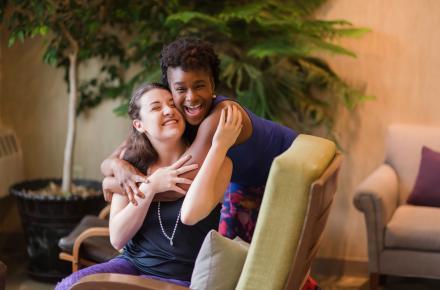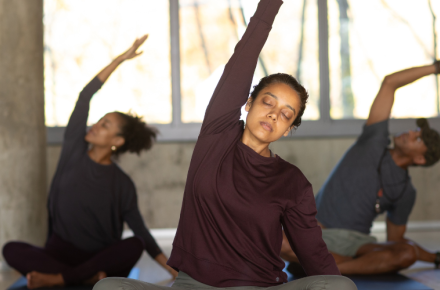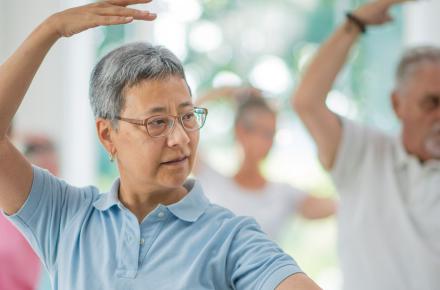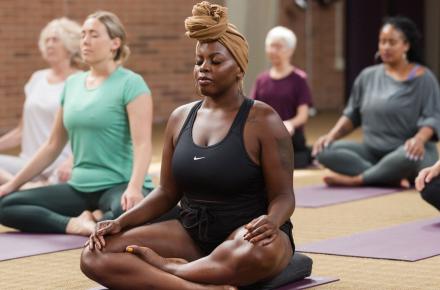The Yoga of Managing Emotional Triggers

July 27, 2020
by Kimberly Jordan Allen
When I’m in a stressful situation, my tendency is to take the “pull-myself-up-by-my-bootstraps” approach and muscle through bravely. Like most of us, I jump in and do what needs to be done, at times ignoring whether it’s good for me or not. That’s something that many of us have been taught to do from a young age. We show up, through thick and thin. But the more I’ve learned about emotional triggers and stress, the more I’ve realized that white-knuckling through can take an enormous toll.
These days, we often hear about people being triggered. If media content is upsetting, there may even be a message prior to viewing that states “this material may be triggering.” When the holidays roll around, SNL does skits about the chaos and dysfunction of family gatherings. It’s become a cliché in our culture that time with family can push our buttons. And it’s not just about family. Work, time with friends, traumatic interactions or experiences of any kind—all can trigger a reaction. Most of us have awareness and sensitivities that can be activated. The question is, what do we do when this happens?
Brené Brown talks about emotional triggers in her book The Gifts of Imperfection, and notes how we tend to move away from our response to triggers. “For many of us, our first response to vulnerability and pain of these sharp points is not to lean into the discomfort and feel our way through but rather to make it go away,” she writes. “We do that by numbing and taking the edge off the pain with whatever provides the quickest relief.”
But going numb only works for a while. And if we don’t address an emotional trigger on the conscious level, it may make itself known in the body. That’s what happened to me recently as I was navigating a particularly challenging situation, relying on my good old muscle-through approach. My brain didn’t do the talking, my body did. I thought I was fine, but when I stopped and slowed down, I noticed that my chest was tight, my back hurt, my breathing was shallow. It was the physical manifestation of the feelings that forced me into action. The body doesn’t lie. I had to listen, and make some life changes to shift the pattern.
How the Body Reacts to Emotional Triggers
When we’re stressed, we have a physical response. The neurological system goes off and “fight or flight” kicks in, catalyzing a set of physical symptoms. Over time, repeated triggers leave the body in a chronic state of stress.
“All experiences, good and bad, leave an imprint in the body,” says Cristie Newhart, Dean of the Kripalu School of Yoga. “The body is a sort of monument to past experiences and memory. When we are faced with emotions that might be painful or uncomfortable, we can ignore or diminish them, but they stay in the body.”
There’s been scientific debate about how exactly we experience emotions manifesting in the body, and whether there is a uniformity to the way we feel. Studies show that we have clear, physiological responses to emotions. One study notes that emotional signatures in different parts of the body are “culturally universal” and tied to biological systems. The body experiences our thoughts and feelings. Hence, when we’re triggered, a specific physical intervention—such as a movement or breathing practice—can ameliorate the symptoms and support us in processing emotions skillfully.
Yoga for Returning to Balance
Awareness is key when it comes to managing emotional triggers. In the words of Swami Kripalu, “The highest spiritual practice is self-observation without judgment.”
“Often, if the experience was traumatic, the stress response remains engaged,” says Cristie. “We further solidify thoughts around our feelings and emotions, which can lead to pain and ailment in the body. This can also lead to unwelcome, unconscious behaviors.” When we allow ourselves to be present and emotionally available for what is happening, we process emotions and feelings in the moment.
The truth is, we all benefit by being conscious of our triggers and holding compassion for ourselves when they’re activated. Yoga, in particular, teaches us to be present for our feelings, emotions, and sensations. The body is sometimes where we actually experience how we feel.
Yoga practice—asana, pranayama, and meditation—are powerful tools for cultivating emotional intelligence. “Yoga is user specific, says Cristie. “Any of the practices can help bring balance to emotions and ignite compassionate awareness. If we approach the practice, remembering why we’re on our mats or cushions, and stay true to our intentions, it’s amazing how quickly we can find the changes we’re looking for.”
It all boils down to communication. Emotional awareness is about balance. When we communicate clearly, from a grounded perspective of calm, we diffuse the emotional trigger. “Learning to communicate what we’re experiencing ina direct and kind way, owning our experience while not blaming others, is key,” says Cristie. “In the midst of a heightened experience, this can be difficult, and the most important thing is to hold both the tapas (discipline) of evolving through our triggers and the ahimsa (non-injury)—remaining compassionate to ourselves, our friends, and our family.” When we ride the wave of emotions, it can feel difficult, challenging, painful. But the learning is always valuable.
Tips for Managing Emotional Triggers
Here are some tips for cultivating emotional self-regulation and learning to manage emotional triggers.
- Slow down. When we react without pause, we don’t give ourselves the space to digest what we’ve experienced or process what we’re feeling. Pause. You’ll always be glad you did.
- Witness. Many of us have gone through moments or times where our feelings were invalidated, even by a well-meaning friend. “You’re fine, don’t sweat it.” This can be a kind sentiment, but in the immediate aftermath of being triggered, it’s not necessarily what we need to hear. And for those who want to be present and bear witness for others, simply saying, “I hear you. I’m so sorry you’re going through this. How can I support you?” might be all a loved one needs.
- Give yourself some love. Sometimes we can be so hard on ourselves, judging our feelings and emotions. Be compassionate with yourself. It’s okay to feel. It’s better than okay! It shows that you are human and that you care.
- Breathe deeply. The breath is your friend. Know it, love it, embrace it. The breath tells the body when things are all right and when they’re not. “When I find myself triggered, the breath is my best ally,” Cristie says. “Breathing deeply and slowly helps shift out of the stress response and make space for a more intentional response to the situation.”
Browse self-discovery programs at Kripalu.
Kimberly Jordan Allen is an award-winning writer, editor, and content strategist.













































